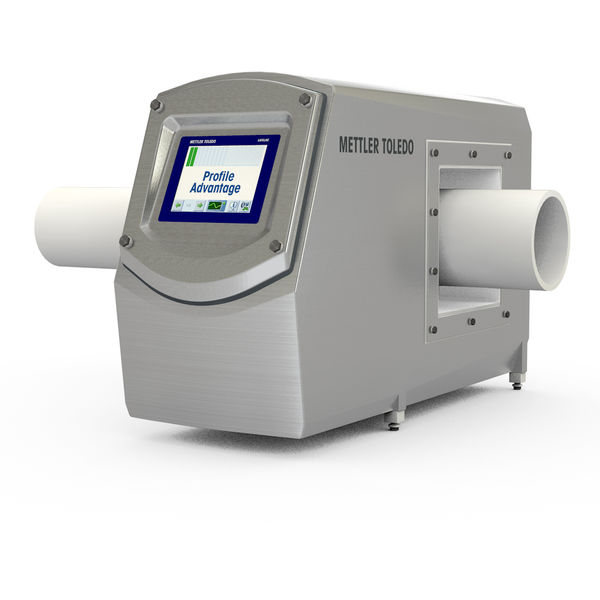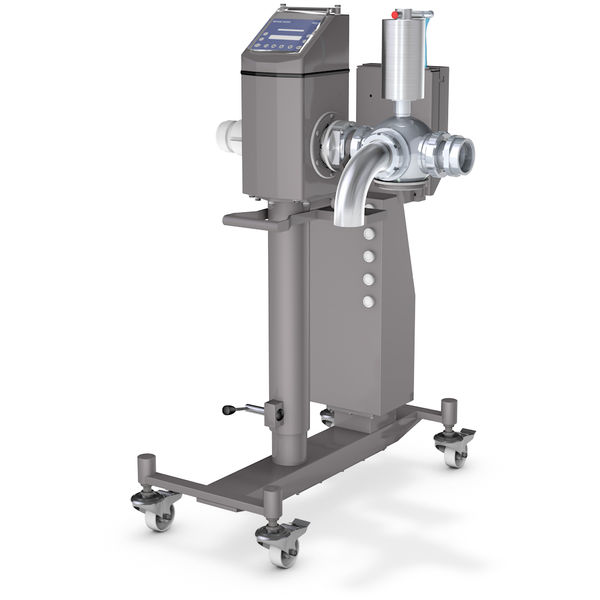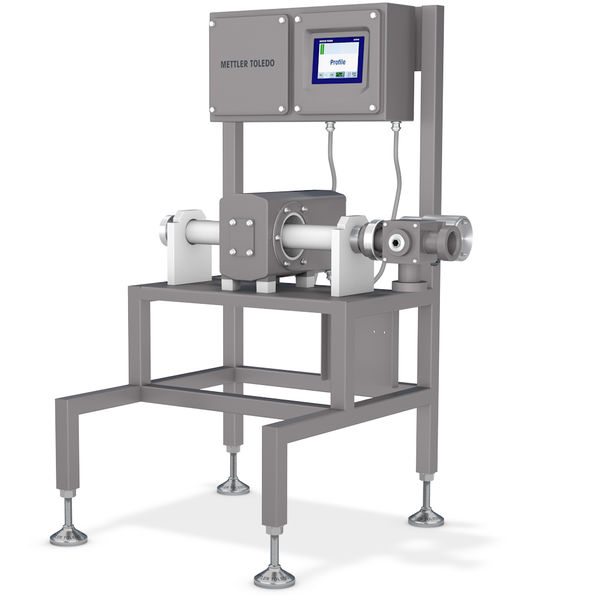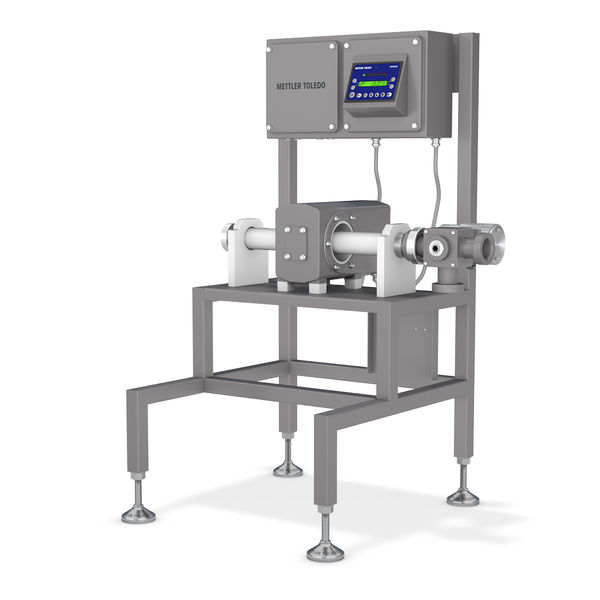
Pipeline Metal Detectors
Pipeline metal detection systems for pumped liquid, slurry, paste, and vacuum-packed applications
Our pipeline metal detectors use advanced technology to deliver reliable sensitivity in the most challenging liquid, paste and slurry applications, including molten chocolate, pumped meats and sauces. Advanced algorithms virtually eliminate false rejects; short throughout pipes minimize product creaming. Increase productivity, reduce waste, and cut your costs while simultaneously protecting your brand.

Pipeline Profile Adv. Metal Detector
Our most advanced pipeline metal detector, which delivers up to 50 percent improved sensitivity to detect smaller metal contaminants when inspecting pumped food products.

HDS Metal Detector
Metal detector designed for meat or sausage manufacturers to inspect high viscosity liquids.
Maximize Your Return on Investment by Ensuring Professional Installation and Right Care Package
Maximize Your Return on Investment by Ensuring Professional Installation and Right Care Package
New Remote Support
Keeping Your Production Running
In addition to our existing 24/7 technical phone support, we offer the latest in remote service support using Augmented Reality (AR) technology. This allows us to provide the quick expert support you need to achieve your productivity goals.
Our METTLER TOLEDO augmented reality-powered visual remote assistance solution helps us to fully understand your service issues. Using a mobile device with an integrated camera enables us to see exactly what you see. We can guide you step-by-step to resolve the issue by providing real-time contextual assistance, such as adding text, drawings, or highlighting objects with 3D markers. Benefit from the fastest fault diagnostics, repair, and part replacement support by using the latest technology. We can also remotely connect to some of our products for additional service enhancement. Please contact your local service team for more details.
Explore our Services
Uptime. Support & Repair
Performance. Maintenance & Optimization
Compliance. Calibration & Quality
Expertise. Training & Consulting
- Bakery Production Metal Detection
- Conveyor & Tunnel Metal Detection Systems
- Gravity Fall Metal Detectors
- Industrial Metal Detector for Agriculture
- Industrial Metal Detector for Cosmetics
- Industrial Metal Detector for Flour and Grain Industry
- Industrial Metal Detector for Meat Processing
- Industrial Metal Detector for the Chemical Industry
- Industrial Metal Detectors for Plastics
- Industrial Metal Detectors for the Dairy Industry
- Industrial Metal Detectors for the Seafood Industry
- Industrial Metal Detectors for the Sugar Industry
- Metal Detection in Ready Meals
- Metal Detection Technology for Snacks and Confectionery
- Metal Detector for Ferrous and Non-Ferrous Metals
- Metal Detectors for Food Processing
- Metal Detectors for Meat, Poultry and Seafood Production
- Metal Detectors for Pet Food
- Metal Detectors for Pulp and Paper
- Metal Detectors for the Food Industry
- Pharmaceutical Metal Detectors
- Throat Metal Detectors
FAQs
How do you choose the best pipeline metal detection system?
Pipeline applications are wide and varied – choosing the right Pipeline metal detection system is critical to achieving maximum performance and brand protection. Pipeline metal detectors inspect pumped liquids, pastes, slurries, high-viscosity and vacuum-filled products for metal contamination. Having the correct throughput pipe, fittings, and reject device will help to efficiently remove metal-contaminated products from the production flow, minimizing the waste of good products.
The following steps guide you through choosing the best pipeline metal detection system for your application.
Step 1: Determine the size of the metal detector
A non-metallic throughput pipe is needed to transport the pumped product through the pipeline metal detection system aperture. The product throughput rate determines the required aperture size and pipe diameter.
Step 2: Consider the temperature of the product
The temperature of the product being inspected will determine the type of throughput pipe required. For example, heated products such as hot jam require a throughput pipe made to handle extremely high temperatures. Molten chocolate requires special water jackets around the throughput pipe to maintain temperature during the inspection process.
Step 3: Determine if there is any pressure in the system
The maximum system pressure must be known to be sure that the throughput pipe can handle the expected pressure. METTLER TOLEDO can supply a high-temperature, high-pressure non-metallic throughput pipe when needed for specific applications.
Step 4: Confirm what fittings are required
Having the correct fixtures to connect the throughput pipe to the rest of your production line is essential. METTLER TOLEDO supplies a range of fittings, custom support frames, floor-mounted and suspended options for easy integration with other production equipment.
Step 5: Choose the right reject mechanism
The right reject mechanism will depend on the product characteristics. Three-way diverter valves are available for most liquid or soft slurry applications, however, if there are any solid elements within the product flow, a specialized reject mechanism may be required.
Related Content:
How do pipeline metal detection systems integrate with other food processing equipment?
Detection of metal contamination in food products in pipes, such as in the inspection of pumped liquids, slurries and pastes, can be achieved by replacing a short section of the metal in the transport pipe with a food-grade, non-metallic pipe that will pass through the metal detector.
Care should be taken in the design and installation so that the replacement pipe will not be under too much strain from the weight of the incoming and outgoing stainless steel transport pipes.
The operator control panel to the metal detector can be installed to be accessed remotely from the search head. This allows the point of inspection to be located in inaccessible places such as high elevations and in complex and congested pipeline networks.
How easily do HDS pipeline metal detectors integrate with other meat processing equipment?
METTLER TOLEDO Safeline HDS Pipeline Metal Detectors are designed for easy integration with other processing equipment.
This inline metal detector can be configured to suit the production of continuous, linked, or clipped sausages and other food products in natural or collagen cases. Internal Cancellation Field (ICF) technology allows the metal fittings of the throughput pipe and other process equipment to be positioned closer to the detection head without affecting the detector performance and sensitivity. This allows a short throughput pipe - which is essential to avoid product creaming - and gives the added benefit of a compact system size to reduce space requirements.
Related Information:
How do your pipeline metal detectors overcome bubbles and voids in product flow?
METTLER TOLEDO Safeline's Profile Advantage Pipeline Metal Detector is ideal for use in challenging applications, particularly when there is a potential for bubbles or voids to be present in the product flow. Using a combination of Multi-Simultaneous Frequency and Product Signal Suppression technology, Profile Advantage Pipeline Metal Detectors can overcome this issue and virtually eliminate false rejects, maximizing operational efficiency and improving productivity.















